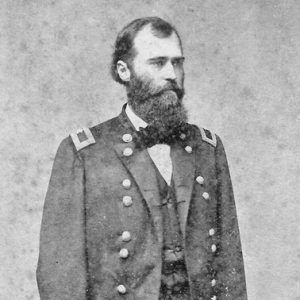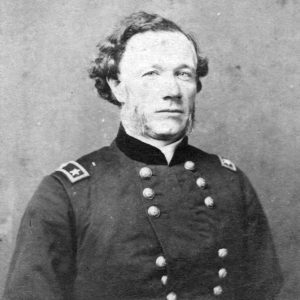calsfoundation@cals.org
Eugene Asa Carr (1830–1910)
Eugene Asa Carr was one of four people who received a Medal of Honor for his role in the Battle of Pea Ridge. Carr also participated in the seizure of Little Rock (Pulaski County), was dispatched to Clarendon (Monroe County) to confront Confederate major general Joseph O. Shelby, and spent time in Helena (Phillips County) on Reconstruction duty. Carr spent more than forty-three years in the U.S. Army.
Eugene Carr was born on March 10, 1830, in Hamburg, New York, to Clark Merwin Carr and Delia Ann Torry Carr; he had three siblings. At sixteen, he entered the U.S. Military Academy at West Point, and he graduated on July 1, 1850. Carr served a tour of duty in Carlisle, Pennsylvania, in the U.S. Army’s Cavalry School. He was assigned to the Regiment of Mounted Rifles and served at Jefferson Barracks in St. Louis, Missouri, in 1851. He served on the frontier at Forts Leavenworth and Scott in Kansas, Fort Kearney in Nebraska, and Fort Gibson in Indian Territory from 1852 to 1854, after which Carr’s company moved to Fort Inge, Texas, to engage with Native American tribes along the Rio Grande. On October 1, 1854, Carr received an arrow wound while fighting the Lipan Apaches. He served during the Border War in Kansas and Missouri from 1856 to 1857 and was promoted to captain and commanded Fort Washita, in Indian Territory, in 1858. His command took part in operations against the Comanche and Kiowa in Kansas and Nebraska in the summer of 1860.
At the outbreak of the Civil War, Carr cast his lot with the Union army, moving his command to Fort Leavenworth and then joining General Nathaniel Lyon in Missouri. He fought at Wilson’s Creek and was brevetted for his service on August 10, 1861. About a week later, he was promoted to colonel and placed in charge of the Third Illinois Cavalry. Carr then assumed command of the Fourth Division, Army of the Southwest, under General Samuel Ryan Curtis.
At the Battle of Pea Ridge on March 7–8, 1862, Carr and Colonel Grenville Dodge were sent to Elkhorn Tavern to “clean out that hollow in a very short time.” Once at the tavern, Carr dispatched Dodge down Huntsville Road to the Clemons Farm to respond to a flanking maneuver on the part of General Sterling Price. Meanwhile, Carr remained at the tavern in order to face General Earl Van Dorn’s push from the north to the south. Carr’s force delayed Price’s movement and allowed Curtis to reposition his troops to meet the combined force of Price and Van Dorn.
In a stern defense around the tavern, Carr was wounded in the neck, right arm, and right leg. For his efforts of courage and bravery on March 7, 1862, he was awarded the Medal of Honor, although he did not actually receive it until 1894. General Curtis mentioned Carr in his after-action report: “Acting Brig. Gen. E. A. Carr, who is wounded in the arm, and was under continuous fire of the enemy during the two days of hardest fighting, where the scattered dead of friends and foes alike attest to the hardest of the struggling.” Soon after Pea Ridge, Carr was promoted to brigadier general, and he spent the rest of 1862 in Arkansas.
By 1863, Carr commanded a division in the XIII Army Corps in General Ulysses S. Grant’s Vicksburg Campaign. His unit fought at Port Gibson, Champion’s Hill, and the Siege of Vicksburg. Carr’s division led Grant’s assault on Vicksburg, Mississippi, on May 18, 1863. In December 1863, Carr was transferred to Arkansas, and by the spring of 1864, Carr commanded the cavalry division of Union general Frederick Steele’s VII Corps in the Camden Expedition, part of an effort by Steele to link with General Nathaniel Banks and then invade Texas. However, this did not go as planned, and in the April 1864 Engagement at Jenkins’ Ferry, Steele ordered Carr to clear a path for his army to retreat back to Little Rock.
In June 1864, Carr was dispatched to Clarendon on the White River with about 3,000 troops with orders to locate and destroy General Shelby, who had captured and scuttled the USS Queen City. In retribution, Carr burned Clarendon to the ground.
Carr returned to Little Rock on June 30, 1864, and served as commander of the District of Little Rock. As commander, Carr became drunk at a dinner party aboard a steamer at DeValls Bluff (Prairie County) and then returned to Little Rock. His superior, General Joseph J. Reynolds, relieved him of command. Carr was then ordered to General Stephen A. Hurlbut’s command at Mobile, Alabama, in April 1865. He commanded the Third Division of the XVI Corps.
Carr married Mary Magwire, and they had four sons; only one lived to adulthood. Carr returned to Arkansas for half a year in Reconstruction duty at Helena in 1867. As commander of the St. Francis District, he provided law and order and recorded the oaths of allegiance of former Confederate officers.
He returned to the frontier in 1869, and for the next two decades, he was engaged in fighting the Apache, Cheyenne, and Sioux in western states. He retired from the army in 1893, and moved to Washington DC. In his later years, he was active in the National Geographic Society. Carr died on December 2, 1910, and was buried at West Point, with full military honors.
For additional information:
Bearss, Edwin C. Steele’s Retreat from Camden and the Battle of Jenkins Ferry. Little Rock: Democrat Printing and Lithographing Company, 1967.
Johnson, Ludwell H. Red River Campaign: Politics and Cotton in the Civil War. Kent, OH: Kent State University Press, 1993.
King, James F. War Eagle: A Life of Colonel Eugene A. Carr. Lincoln: University of Nebraska Press, 1963.
Knight, James R. The Battle of Pea Ridge: The Civil War Fight for the Ozarks. Charleston, SC: The History Press, 2012.
Piston, William Garrett, and Richard Hatcher III. Wilson’s Creek: The Second Battle of the Civil War and the Men Who Fought It. Chapel Hill: University of North Carolina Press, 2000.
Schultz, Robert G. The March to the River: From the Battle of Pea Ridge to Helena, Spring, 1862. Iowa City, IA: Camp Pope, 2014.
Shea, William, and Earl J. Hess. Pea Ridge: Civil War Campaign in the West. Chapel Hill: University of North Carolina Press, 1994.
Sifakis, Stewart. Who Was Who in the Union Army: A Biographical Encyclopedia of More Than 1500 Union Participants. New York: Facts On File, 1988.
Warner, Ezra. Generals in Blue: Lives of Union Commanders. Baton Rouge: Louisiana State University Press, 1992.
Kerry King Jones
Fayetteville, Arkansas









Comments
No comments on this entry yet.